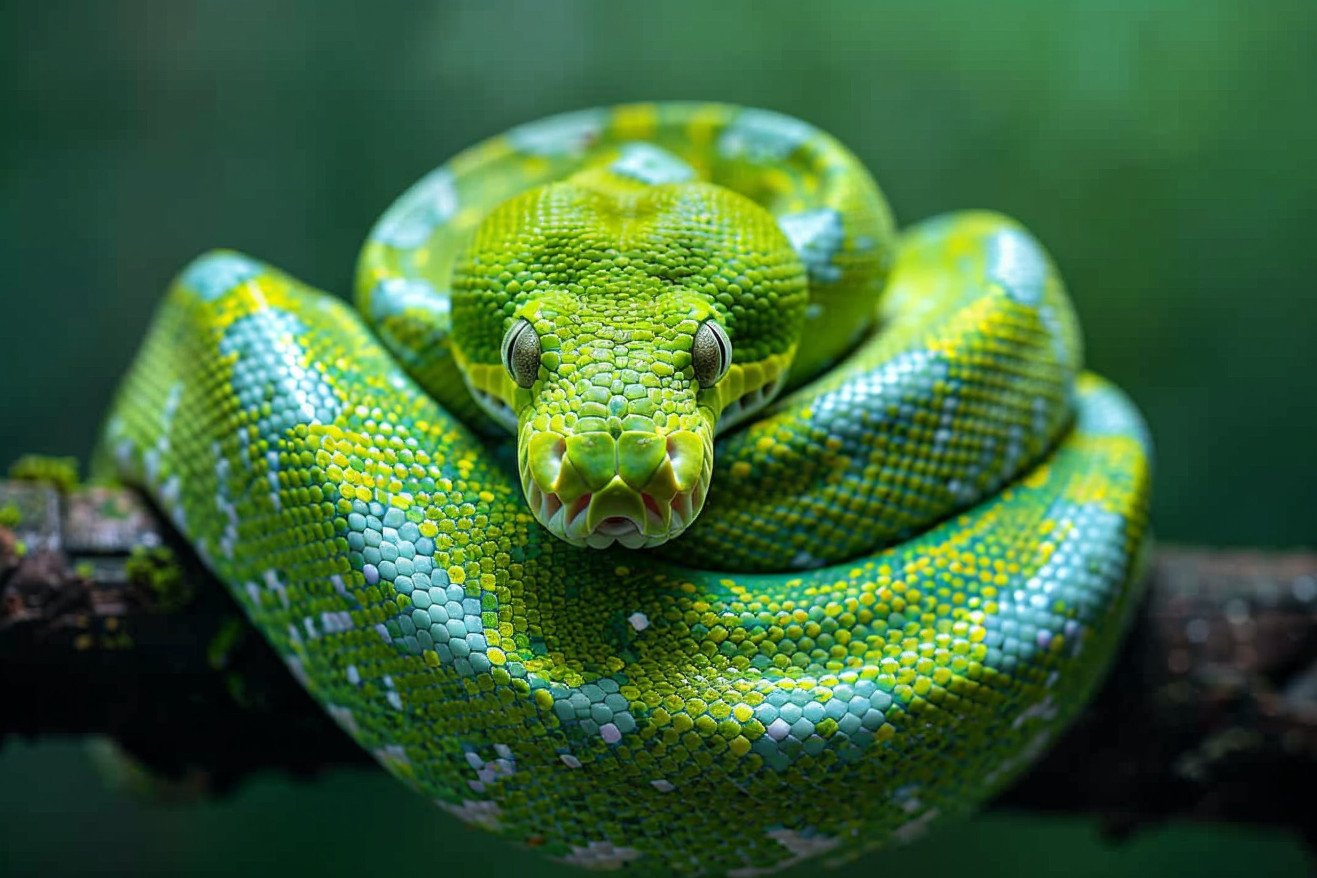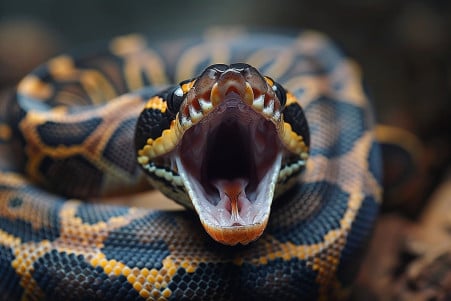Can Snakes Fart? An Investigation into Reptile Digestion
4 March 2024 • Updated 4 March 2024

While it’s often the butt of jokes, farting in snakes is a strange biological phenomenon. Snakes do fart, although it’s not well-documented. It happens less often than in mammals, which is due to differences in gut bacteria and a slower metabolism. If a snake farts too much, it could be a sign of a digestive issue, and you should take your snake to the vet.
To help you better understand this part of snake biology, we’ll look at a variety of zoological and veterinary studies. We’ll also look at how snake digestion and the presence of bacteria in snakes compares to other animals to help explain why snakes do or don’t fart.
In the end, you’ll have a better understanding of how snakes’ diets, metabolisms, and anatomies affect their digestion, and you’ll know the answer to the question of whether snakes can fart from a scientific perspective.
Can snakes fart?
The Serpent’s Breath: Gas Exchange and Lung Asymmetry
Snakes have a highly specialized respiratory system that is notable for its asymmetry, which is thought to be central to their gas exchange capabilities, including the ability to expel gas from their digestive system.
A paper published in the journal PMC found that snakes show marked left-right asymmetry in their cardiorespiratory development. The right lung is usually well developed, while the left lung is either absent or vestigial. This asymmetry is thought to have an impact on both respiratory efficiency and the snakes’ ability to expel digestive gases.
It’s thought that the asymmetrical development of snakes begins in the embryonic period, which may have implications for gas expulsion in adulthood. In some species, the presence of a ‘tracheal lung’ further increases the diversity of their respiratory system and gas exchange.
These differences in anatomy are a sign of the evolutionary changes snakes have gone through, which may have an impact on the release of their digestive byproducts, as suggested by Robert E. Poelmann’s research.
Investigating the relationship between respiratory adaptation and digestive function helps explain some of the quirks of snake biology. While more research is needed to determine if there is a direct relationship between lung asymmetry and flatulence, the evolutionary changes that have led to the structure of snakes’ lungs have likely played a role in their unique physiological makeup.
This brings us to the next part of the puzzle: the impact of gut microbiota on reptile digestion.
The Gut Microbiome of Snakes
The gut microbiota of reptiles, including snakes, is a diverse and complex community that is important for digestion and other physiological processes. A paper published in PMC found that the gut microbiota of reptiles is influenced by a variety of factors, including diet and environment.
The metabolic activities of the gut microbiota are important for digestion and can lead to the production of gas. In snakes, the gut bacteria, which are mainly made up of Firmicutes, Bacteroidota, and Proteobacteria according to Molecular Ecology, are responsible for the breakdown of prey tissue, which can lead to the production of gas.
A study in the Journal of Applied Microbiology even suggests that the relationship between reptiles and their gut microbiota has been co-evolutionary. This relationship has important implications for the immune system and overall health of snakes, and the relationship between the gut microbiome and the immune system is important. The gut microbiota protects against pathogens and maintains the health of the gut lining by producing antimicrobial peptides and other metabolites.
Investigating the relationships between these microorganisms and their reptilian hosts can help to better understand the less well-known aspects of snake digestion and gas production. In addition, the importance of the gut microbiota goes beyond digestion and can help to understand snake health and even longevity.
Snakes vs. Other Animals: A Digestive Comparison
Snakes have a digestive system that is unlike any other animal, and this has a direct impact on how much gas they produce. According to Reptiles Magazine, the snake digestive system is highly efficient and, after eating, snakes undergo a number of physiological changes.
Their heart grows in size, as do their internal organs, including the pancreas and liver, to meet the metabolic demands of digesting large prey. This means that the microbial community in the gut is less diverse and therefore less likely to produce gas.
Meanwhile, the Gastrointestinal Society explains that the snake digestive system is very different from that of ruminants, such as cows, which have a complex gut microbiome that helps them digest plant-based food. On the other hand, snakes have a simple gastrointestinal tract (GIT) but a complex postprandial response, including an increase in the ability to expel gas, that is required to meet the metabolic demands of digesting large prey.
These digestive differences are not only a result of their carnivorous diet but also have an impact on their overall health and behavior. The combination of infrequent meals and the metabolic demands of digestion means that snakes are likely to have infrequent bowel movements and therefore pass gas less often. This is likely a normal part of the digestive process.
The lessons learned from studying reptile digestion can help us understand animal physiology more broadly and the many ways that animals have adapted to survive and thrive.
The Flatulence Phenomenon: A Cross-Species Examination
Flatulence, a natural byproduct of digestion, is a biological process that varies greatly across species. Most animals, including humans, exchange gases through a process called diffusion across moist membranes, which is explained in the article, Mechanisms for Gas Exchange.
Different species, from earthworms to mammals, have adapted unique ways to expel gas through skin, gills, or specialized respiratory systems. In the case of mammals, microorganisms ferment the gut’s contents, which leads to the production of gases like carbon dioxide and methane that are then expelled as farts.
In the case of snakes, their digestive systems are less fermentative than mammals, which means there are fewer opportunities for gas to be produced. However, as a report by Vox points out, there are also examples of snakes like the Sonoran coral snake that suck in and expel air as a defense mechanism, which shows that the lines between what is and isn’t considered flatulence can be a bit blurry.
This suggests that while snakes may not have as well-defined a biological process for flatulence as mammals, they aren’t completely without one either.
The range of functions that flatulence serves in different species is also interesting. For example, herring use farts to communicate, while manatees use their flatulence to control their buoyancy.
This raises interesting questions about what the potential but as yet undiscovered roles of snake flatulence might be in the species’ ecological niches. It also shows how learning about these processes can help expand our understanding of the natural world and keep us asking questions about animal physiology.
Unraveling the Mystery: Do Snakes Fart?
Our deep dive into snake digestion and flatulence has shed light on some of the more interesting aspects of reptilian physiology.
While snakes may not fart often, the few times they do have helped to show just how different their digestive system is.
From the way their lungs are set up to the bacteria in their gut to the fact that they eat other animals, all of these things have come together to make snake farts rare and unique. And when we compare snake farts to the farts of other animals, it shows that there are a lot of different reasons for flatulence, from communication to buoyancy.
The fact that we know so little about snake farts in the wild just goes to show how much we still have to learn about snake physiology and the ins and outs of their digestive system.
But learning about these things isn’t just about satisfying our curiosity. It can also help us learn more about the world around us and how it’s evolved. Clearly, there’s a lot that herpetologists and ecologists can learn from studying snake digestion.
In wrapping up our look at snake digestion and flatulence, we hope that this article will inspire more research into the digestive systems of snakes and the many ways they’re different from other animals. Each new discovery will help us continue to unravel the mysteries of these fascinating animals and the world they live in.


